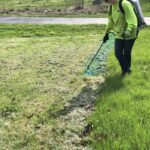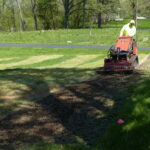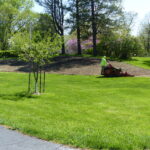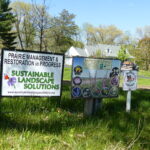Moving Forward
Once we made the decision to convert about 3,000 square feet of our lawn to a prairie, we began active planning. We have 40 years of prairie establishment and management experience so it was easy for us, but we still needed help and sought partners.
We contacted many organizations and found support for our project from these people and groups:
Sustainable Landscape Solutions, a business based in Iowa City. We hired them to do ground preparation. Sean Pearl is the owner.
Monarch Research Project, an active Cedar Rapids-based group that encourages pollinator plantings.
Linn County Secondary Roads. Since our prairie is near a Linn County road we wanted their support.
Pheasants Forever. We received help from a biologist, Allie Rath, and bought an outstanding seed mix from Pheasants Forever. Matt O’Connor manages the seed store and encouraged us to buy a Leopold Mix that contains about 72 species of flowers. Our seeds were produced at the Allendan Seed Company in southern Iowa.
Good Neighbor Iowa. This organization encourages people to shun lawn chemicals and plant native vegetation. A key contact is Audrey Tranlam.
Requirements
We wanted the prairie to be diverse in plant species, establish as rapidly as possible, and be “short profile”. Meaning we did not plant tall big bluestem, Indian grass, and Switchgrass.
We chose the Leopold mix because it has a diversity of flowering plants. And, Pheasants Forever kindly removed the tall-growing grasses from the mix for us.
Preparing and Seeding
Years ago when we began restoring prairies at Indian Creek Nature Center, it was impossible to buy seed, and little was known about how to establish a healthy native grassland. The Center had no money to invest in planting. Jock Ingels was a savvy restorationist based in Illinois. He gave us this advice, “If you don’t have any money but want a prairie, go pick some seeds and broadcast them into the existing lawn. Then burn it. Then wait. You’ll think you wasted your time because nothing will show after a year or even two years but burn it annually. By the third year, you’ll see prairie plants appear and it will get better each year after.” He was right. We gathered seed, planted at the Indian Creek Nature Center, and burned it annually.
At the Nature Center, we got a prairie at no cost and avoided herbicides and ground preparation but it had a limited diversity of species. The newly established prairie was far healthier ecologically than the bromegrass that was once there. For the prairie we wanted to establish at our home, we wanted a more diverse prairie and more quickly. So, we chose a faster method. Mind you, we are not keen on sprays but recognize they have a place.
Sustainable Landscape Staff sprayed our lawn with roundup in late April to kill the grass. They returned one week later and resprayed it to kill the remaining grass.
- Caitlin carefully applies spray.
- Tilling up the lawn.
- Finishing the edge.
- Three cooperators’ signs.
They returned a week later and rototilled the area to expose the soil. Spraying and tilling allows newly planted native seeds to grow with less competition from exotic lawn species. It emerges as a more diverse prairie faster than if spraying and tilling are avoided.
In the next installment of this series, we’ll show photos of us seeding the prairie and explain various other ways of establishing a prairie or pollinator meadow. But because lawns are now growing and people are mowing we’ll leave with this thought:
There’s a no-cost method of diversifying a lawn that reduces work. Simply mark off a section of the lawn and don’t mow it. It can be small. Many native plants have durable seeds that remain dormant in the soil for years or decades. They can’t succeed with constant mowing, so to increase plant diversity simply stop mowing a section of lawn and try to identify the new plants that emerge. You will help pollinators.
There’s a new phone app that we’re using to help identify plants we’re not familiar with. It’s called SEEK and is produced by the National Geographic Society, the California Academy of Science, and other groups. It’s free and can be accessed from the app store. You point the phone at a plant, insect, bird, or even a fungus, click a photo, and SEEK will identify it for you. It’s mostly accurate.





